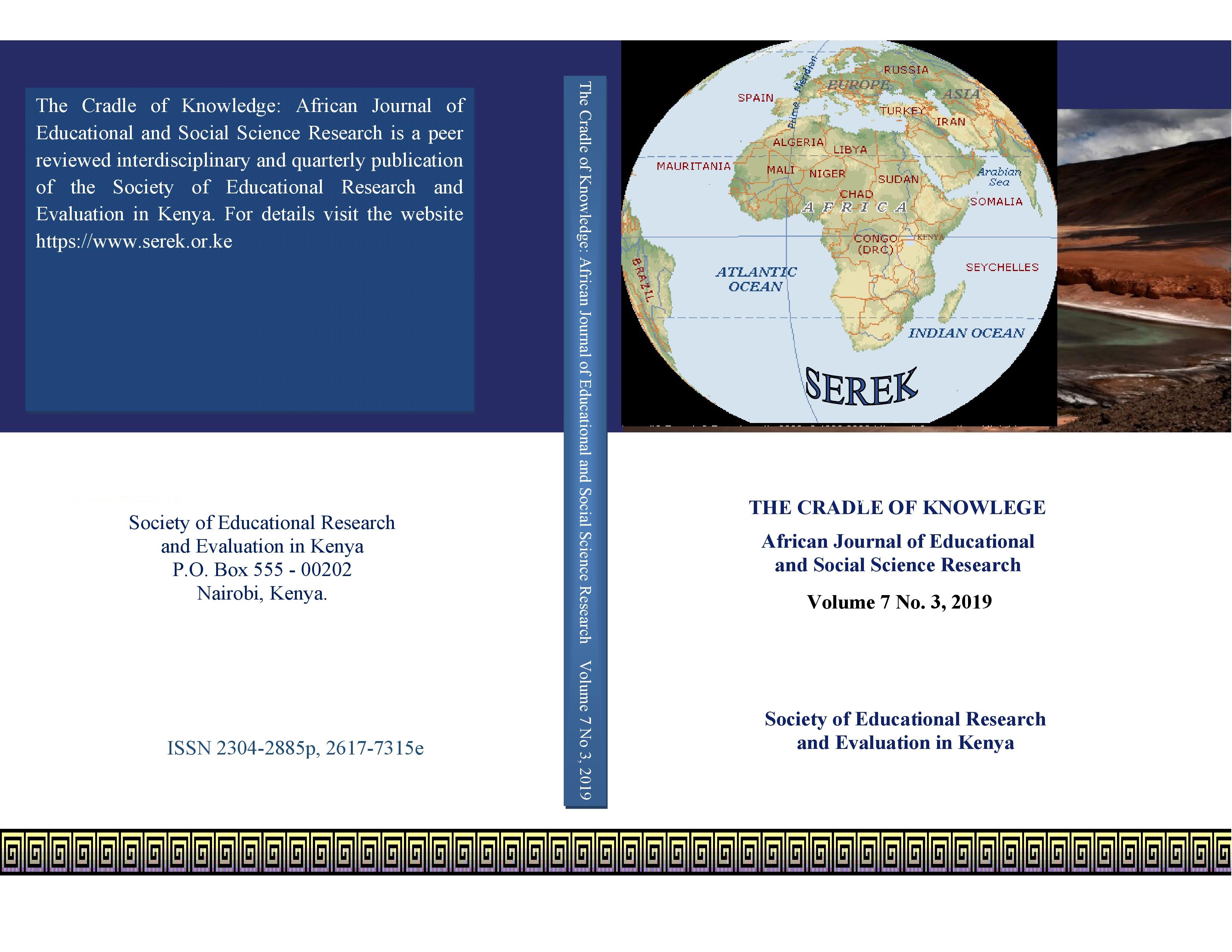
Alternative Income Generating Activities for Financial Sustainability of Higher Education Institutions
Abstract
The huge increase in the cost of universities are starting to seriously ward off potential customers and alienate the public, whose support of colleges is waning. For the last five years, aggregate universities' enrollments in Kenya have fallen, and alternative Income Generation Activities (IGAs) to supplement the tuition income have become a necessity for institutions to grow economically and be sustainable in their business. This paper aims to examine better ways Higher Education Institutions (HEIs) approach financial management, including HEIs choice in allocating institutional resources. In today’s world, competition is a driving force for innovation and entrepreneurship with higher education not spared to unfair practices. For example, Africa, including Kenya, loses approximately 23,000 qualified professionals to the west every year. This is a theoretical paper; based on financial management theory, that explains the gap between the educational knowledge and business practices in the education industry. An expenditure-based budget allocation model for HEIs' resource allocation is developed as a new financial management framework. It is based on the premise that HEIs exists not only to educate students, but also to contribute to the development and furtherance of knowledge, and contribution to the nation's economic growth in terms of expertise and commercialization of intellectual property; this paper contributes to conversations and policies on financial management practices and alternative IGAs for HEIs.
Keywords: Sustainability; Financial sustainability; and Financial Innovations.
Full Text:
PDFReferences
Afriyie, A. O. (2015). Financial Sustainability Factors of Higher Education. International Journal of Education Learning and Development, 2(3), 17–38. Retrieved from http://www.eajournals.org/wp-content/uploads/Financial-Sustainability-Factors-of-Higher-Education-Institutions.pdf
Al-Hamadeen, R. and Malek, A. (2014). Financing Higher Education Institutions: Experience of the Jordanian Public Universities (2014). Research Journal of Finance and Accounting, 5 (8): pp. 185-194, 2014. Available at SSRN: https://ssrn.com/abstract=2707130
Al-Kharusi, S., & Murthy, S. R. (2017). Financial sustainability of private higher education institutions: The case of publicly traded educational institutions. Investment Management and Financial Innovations, 14(3), 25–38. https://doi.org/10.21511/imfi.14(3).2017.03.
Austin, J. E. (2000). The Collaboration Challenge: How nonprofit and business succeed through strategic alliances.San Francisco, CA: Jossey-Bass.
Bergquist, A.-K. (2017). Business and Sustainability: New Business History Perspectives. Ssrn. https://doi.org/10.2139/ssrn.3055587
Calder, W., & Dautremont-Smith, J. (2009). Higher education: More and More Laboratories for Inventing a Sustainable Future. Agenda for a Sustainable America, 93–107.
Cameron, K. (2006). (2nd Revise). Chicago: Josey Bass. https://doi.org/10.1111/j.1744-6570.2006.00052_5.x
Danciu, V. (2013). The sustainable company: new challenges and strategies for more sustainability. Theoretical and Applied Economics, XX(9586), 7–26.
Ernst & Young. (2015). 4 Advantages of Incorporating Sustainability Strategies Into Your Business, 2. Retrieved from http://www.ey.com/Publication/vwLUAssets/EY-4-advantages-of-incorporating-sustainability-strategies-into-your-business/$FILE/EY-4-advantages-of-incorpora Procedia Economics and Finance 26 ( 2015 ) 1152 – 1158ting-sustainability-strategies-into-your-business.pdf.
Goksu, A. & Goksu, G. G. (2015). A Comparative Analysis of Higher Education Financing in Different Countries. Procedia Economics and Finance 26, 1152 – 1158.
Interdonato, D.(2012). Streamlining sustainability: Building information modeling opens numerous avenues for industrial engineers. Industrial Engineer, 41- 44.
Leicht, A., Heiss, J., & Byun, W. J. (2018). Issues and trends in Education for Sustainable Development. Retrieved from https://en.unesco.org/themes/119915/publications/all?page=2
Johnson, S. & Kwak, J. (2012). Is Financial Innovation Good for the Economy. Innovation Policy and the Economy 12, 1 - 15. Retrieved from The National Bureau of Economic research.
Lopez, Y. P., & Martin, W. F. (2018). University Mission Statements and Sustainability Performance. Business and Society Review, 123(2), 341–368. https://doi.org/10.1111/basr.12144
Mandell, L. & Klein L.S. (2009). Impact of Financial literacy Education on Subsequent financial Behavior. Journal of Financial Counselling and Planning, 20(1), 15-24.
Marcus, R. D.(2012). Internal and sustainable growth rates in the presence of scale economies. Marcus, Richard D., Internal and Sustainable Growth Rates in the Presence of Scale Economies (August 28, 2012). Available at SRN: https://ssrn.com/abstract=2138341 or or http://dx.doi.org/10.2139/ssrn.2138341
Michael, M.(2018). Why Organization Culture Matters. Creating structure and culture for Innovation. Retrieved from: https://www.researchgate.net/publication/329140215.
Nóbrega, L. B. da. (2017). Promotion of Sustainability in Higher Education Institutions: Iscte-Iul, (October). Retrieved from https://repositorio.iscte-iul.pt/bitstream/10071/15780/1/lia_barbieri_nobrega_diss_mestrado.pdf
Petrini. (2010). St. Benigne, dijon. BAR, Curitiba, 7(4), 362–378. https://doi.org/10.1093/nq/s2-XII.296.168-a
Zsolnai, L. (2013). the Role of Public Relations in Building a Sustainable Corporate Image : a Study of Benue State Internal Revenue Service ( Birs ).
Refbacks
- There are currently no refbacks.
License URL: https://www.serek.or.ke
SEREK publication https://serek.or.ke
This work is licensed under a Creative Commons Attribution 4.0 International License